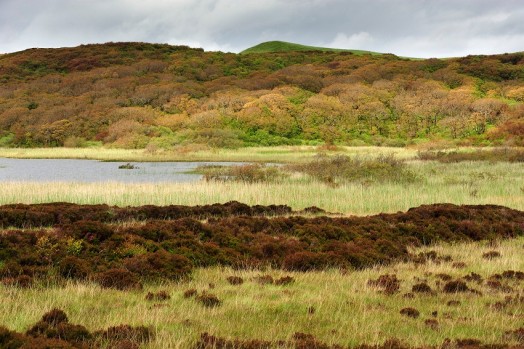Supporting guidance for Habitat Mosaic Management
Date published: 9 November, 2017
For recent changes to this guidance, please see the bottom of the page.
Note: On 28 February 2024 the ‘Guide to Conservation Grazing (SAC)’ at the ‘Further Information’ section was removed and replaced with an updated document titled: ‘Conservation Grazing for Semi-Natural Habitats FAS Technical note TN686’
Introduction

Areas of high conservation value often consist of a variety of different wildlife habitats.
If your site comprises of a combination of 2 or more habitat types, it can be managed under the habitat mosaic option.
If the area you intend to manage is predominantly one habitat type, such as species-rich grassland or wetland, then it should be managed under the specific option for that particular habitat.
If the site is a mosaic of traditional semi-natural habitats then this option is likely to be more suitable.
The range of habitats that can be included in a habitat mosaic includes:
- species-rich grassland that has not been agriculturally improved, or species-rich grassland that is reverting from agricultural improvement. (The document – Guide to types of species-rich grassland – describes the grassland habitats)
- wetland (e.g. fen meadow) and wet grassland. Wetland supporting guidance
- scrub and tall-herb communities
- heath (please note that the site must contain no more than c25 per cent heath
- pockets of woodland
- wood pasture
- parkland trees
Coastal mosaics with species-rich grassland and heath should be entered into the Coastal Heath management option. Grazed woodlands should be entered into the Forestry Grant Scheme, unless the site meets the Ancient Wood Pasture eligibility.
Land eligibility
You will need to consider if land previously managed in Rural Priorities under the Habitat Mosaic Management option, meets the new AECS eligibility requirements.
This option, with its associated payment rate, is primarily to fund management of species-rich habitat mosaics below the hill dyke. Whilst these mosaics may contain small pockets of heather dominated habitat, sites which have more than c25 per cent rough and agriculturally unproductive ground, (which may comprise heath, blanket bog, raised bog etc.) are ineligible for funding, as the payment rate has been calculated based on ground that can support a certain stocking level, and this type of ground does not meet these requirements.
If your site is dominated by these habitat types, it may be eligible for the heath, wetland, lowland raised bog or moorland management options. Alternatively, reduce the claim area for the Habitat mosaic option on the field.
Example: A field of 10ha with 65 per cent species-rich grassland/wetland mosaic and 35 per cent blanket bog would be eligible to claim 6.5 ha habitat mosaic management over the total area.
This option will support the maintenance of habitat mosaics lying below the hill dyke.
If you wish to include land above the hill dyke in your application you should explain why you consider this land to be habitat mosaic rather than moorland. You must provide either a Phase 1 habitat map of the area, (including species lists and target notes and showing the extent of the different habitats), or a map of the National Vegetation Classification communities.
Land previously managed as moorland should continue to be managed as moorland.
Where blanket bog is present across a large proportion of the site, or where it is unclear what land is in-bye, or below the hill dyke, please contact RPID before applying to consider the suitability of land within these areas for the Habitat Mosaic Management option and whether a Phase 1 survey is required.
Many species of wildlife require a mosaic of different habitats. They may feed in one habitat but rely on another for shelter. Examples include black grouse, great crested newt, adder, lapwing and song thrush. You will need to design a management regime which helps to conserve and enhance the habitat mosaic, prioritising the most important habitat or species if necessary.
Knowledge of the past management regime will help to inform what management has worked for the site. You should draw up a management plan with advice from a suitably qualified advisor.
Grazing
Grazing is essential to maintain many of the different habitats found within a habitat mosaic. Grazing harvests the year’s growth and keeps the sward open and free of excess litter so that new seedlings can become established. At the same time, the trampling, dunging and defoliation of stock all contribute to creating a variety of features, including tussocks, flower heads, short swards and small patches of bare earth.
Different habitats have varied requirements and sensitivities. The grazing plan should be based on a site survey which assesses the extent of the different habitats and their grazing requirements.
Certain habitats are more sensitive at certain times of the year. For example:
- species-rich grassland habitats are vulnerable to heavy selective grazing in the summer, particularly by sheep
- woodland / scrub regeneration and heather are vulnerable to grazing damage in the winter when more palatable vegetation is in short supply
- wetland and bog habitats are vulnerable to excessive poaching, particularly in the winter months
- the nests of wading birds are vulnerable to trampling by livestock between early April and early June
The guide – Conservation grazing of semi-natural habitats – will help you to determine the aims of grazing and the ideal stocking rates for the site. You can also consider the current stocking rate, how well that meets the needs of the range of habitats present, and how and what adjustments may be needed.
You must submit a grazing plan, using the template below, with your application. The plan needs to detail what grazing will be carried out, as well as describing the current condition of the site and the objectives for management. The plan should specify the number and type of stock for the different seasons. All stock movements must be recorded in your Management Diary.
It can be difficult to set appropriate stocking levels where there are different habitat requirements and weather can have a significant impact from year to year. As a result, you may need to modify your grazing plan during the contract if it is not fulfilling the site requirements. You can do this by seeking approval (in writing) from the case officer to change the plan.
Other management
Habitat mosaics will often support a wide range of valuable features such as dead wood, bare earth, habitat piles, varied grass swards, leaf litter, open bracken and scrub.
Management work can be carried out to enhance the features found on habitat mosaics. Examples of funded capital items that may benefit habitat mosaics include:
Scrub

Areas of scrub significantly add to the diversity of habitat mosaics sites and can be of particular benefit to insect species, amphibians and reptiles.
However, the extensive spread of scrub on grasslands and heath of conservation interest is generally undesirable. Appropriate grazing management should help prevent scrub colonisation. Additional manual scrub control may be necessary.
Scrub control is funded as separate capital items:
Weed control
Particular weed species, such as dockens, ragwort and creeping thistle, can be a problem in mosaic habitats. Weeds will need to be controlled where they are having an adverse effect on the conservation value of the habitat.
Weed encroachment can become a problem if poaching or supplementary feeding has occurred on a site.
Weeds can be chemically spot-treated provided you have prior written agreement from your case officer.
If the site you propose to manage suffers from weed encroachment, you will need to state how you plan to control weeds over the course of your contract in your Grazing Management Plan.
Bracken
The spread of bracken gradually smothers ground vegetation, resulting in the loss of areas of species-rich grassland, heath and other habitats. Where possible, bracken control should be undertaken whilst a reasonable range of wildflowers and grasses remain beneath the bracken.
If the ground vegetation has been completely replaced with dense bracken litter, it may be necessary to take advice about how to encourage the ground vegetation to regenerate. As a last resort it may be necessary to purchase a suitable seed mix to re-seed the area, once the bracken litter has been dispersed by livestock trampling.
Open bracken can be a valuable part of the habitat mosaic and can provide good habitat for ground-nesting birds and reptiles such as adder. Bracken on south-facing slopes is an important element of pearl bordered fritillary butterfly habitat and care should be taken when controlling bracken where this species is present.
Bracken control can be undertaken as part of your plan and separate funding is available for this.
- Primary Treatment of Bracken – Manual
- Primary Treatment of Bracken – Mechanised or Chemical
- Follow-up Treatment of Bracken – Mechanised or Chemical
Areas of dense bracken, which result in land being ineligible for BPS, cannot have bracken treatment funded through AECS. This must be undertaken at the owner’s expense.
Supplementary feeding
No supplementary feeding is permitted on sites managed as habitat mosaics, unless you have prior written approval from SNH or RPID submitted with your application. Approval will only be granted in exceptional circumstances.
Further information
- Grassland management guide - Nature Scot
- Types of species rich grassland (NatureScot)
- Species Rich grasslands – what they are and why they matter (NatureScot)
- The effects of supplementary feeding on species-rich grassland guidance
- Conservation grazing for semi-natural habitats (FAS technical note TN686)
- Land management for butterflies (SAC)
- Grassland Gems: Managing Lawns and Pastures for Fungi (Plantlife)
- Management of grasslands for insects (Buglife)
- Reptile Management Handbook (Amphibian and Reptile Conservation)
- Amphibian Management Handbook (Amphibian and Reptile Conservation)
Recent changes
| Section | Change |
|---|---|
| Weed control | We've updated the guidance regarding weed control |
Previous versions
Download guidance
Click 'download this page' to create a version you can save our print out
